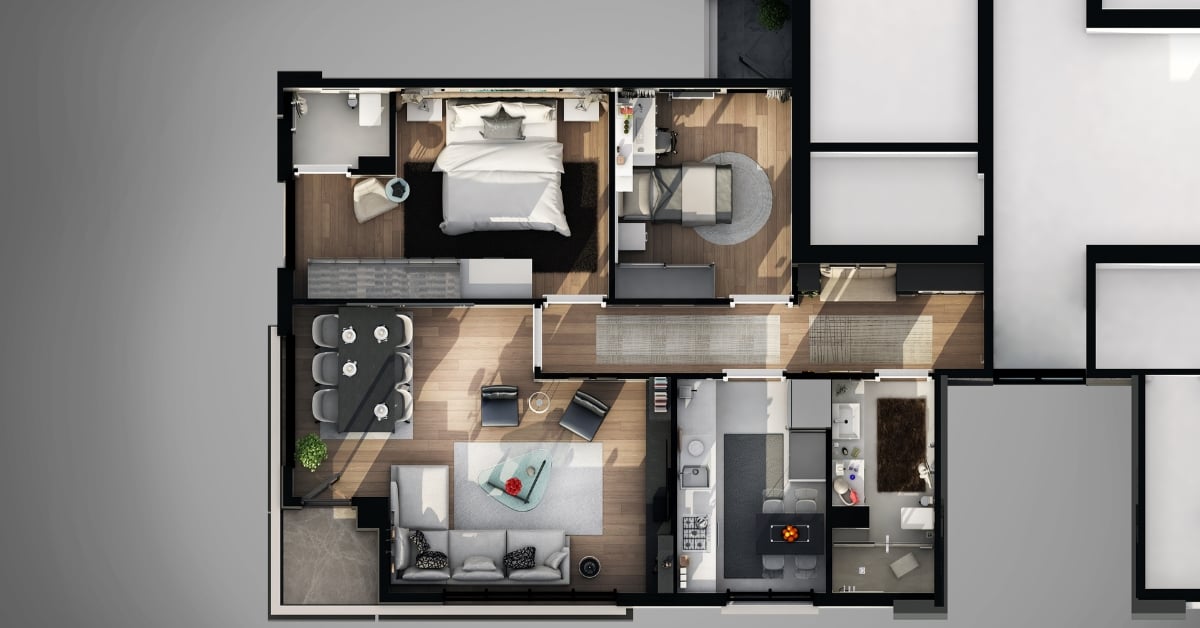From Viewing to Buying: How Floor Plans Transform Property Sales

A valuable marketing asset favoured by potential buyers is an elaborate floor plan of your property.
What exactly is a floor plan?
A floor plan is a meticulously crafted, scaled drawing that offers a top-down perspective of a room. It depicts the spatial relationships between various rooms, areas, and other physical attributes on each level of a building. Furthermore, these plans contain dimensions that indicate room sizes and wall lengths.
Floor plans are widely showcased on property websites, showcased in image galleries, and integrated into promotional materials distributed during open house viewings and various sales channels.
The role of floor plans in property sales
Before prospective buyers visit your property, a professionally designed floor plan, illustrating the complete layout, plays a pivotal role in helping them comprehend the flow of the property.
It serves as a vital tool to aid them in envisioning how the space might suit their needs. Also, it allows them to determine if there's any scope for future modifications as their requirements evolve.
Post-viewing, the floor plan serves as a valuable memory aid regarding the property's layout. It empowers serious buyers to strategically plan their furniture placement. As they start visualising their belongings within your property, their enthusiasm for the property is likely to surge.
Afterall, Enthusiastic buyers are a key ingredient for a successful sale.
Even if your property's layout isn't flawless, the floor plan provides potential buyers with insights into how the interior could be altered to better align with their needs. For example, your kitchen might be positioned in the heart of the property, with no direct connection to the garden. In today's market, many buyers value a seamless transition between indoor and outdoor spaces. By utilising a floor plan, potential buyers can evaluate the possibilities for making alterations. Transforming the property into their ideal dream home.
Satisfying the buyer's information quest
As you may recall from your own property buying journey, buyers are keen to gather as much information as possible about a property they are considering. A well-designed floor plan serves as an essential and invaluable marketing tool that complements the information available about the property.
The floor plan allows prospective buyers to integrate the images and gain insights into the layout of rooms, their relative positions, and their relationships within the property. It also provides details on window placement, the layout of kitchens and bathrooms, the availability of built-in storage, the property's orientation (always featuring the North symbol), and, in the case of houses, the property's placement on the plot. The synergy between photos and floor plans helps buyers make sense of the property, which is a pivotal step in attracting them to an open home.
How are floor plans generated?
In most cases, photographers are entrusted with creating the floor plans. They employ precise laser measurements of each room to craft a meticulously scaled floor plan, complete with room dimensions and the property's overall size. Some floor plans even depict the property's footprint on the plot.
Varieties of floor plans
There are several types of floor plans available, so it's advisable to consult your real estate agent regarding the most suitable option for your property.
The simplest plans are monochrome sketches, but there are also coloured alternatives that make your property stand out, as well as plans featuring textured elements like decking or tiling. Furniture can be added to any plan to provide prospective buyers with a sense of potential furniture arrangement.
Interactive floor plans are also popular, allowing potential buyers to place and move furniture throughout the house to get an idea about size and flow.
Six tips for crafting an exceptional floor plan
Your real estate agent will play a pivotal role in ensuring your floor plan is accurately designed. Nevertheless, here are six key elements that contribute to the creation of a remarkable sales tool:
- Always include precise dimensions and measurements to provide potential buyers with an accurate understanding of the property's scale.
- Clearly indicate the property's orientation by marking the North direction, as this helps buyers grasp the property's alignment.
- Opt for straightforward plans, as council or building plans can be overly intricate and perplex potential buyers.
- When selling a house, consider adding a site plan, as it illustrates how the house fits within the plot.
- Contemplate using full-colour plans, as they are more visually appealing.
- Ensure your plans incorporate details of windows and doors, including their positions and sizes, to assist buyers in planning their furniture arrangement.
Floor plans constitute an indispensable component of your marketing strategy, and they are highly coveted by prospective buyers.
It's advisable to talk with your real estate agent about the type of floor plan most suited to your property. It represents a worthwhile investment and is what we consider an essential component when bringing your property to market.
Share


